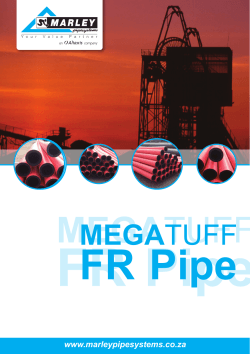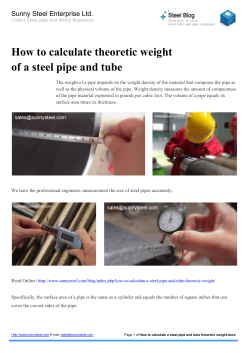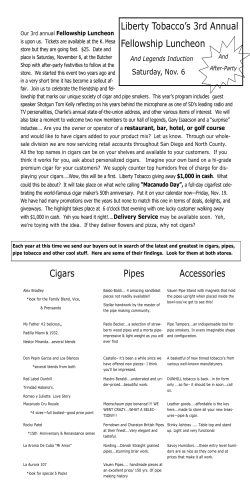
Document 218490
U.S. Mayor Article | How to be Environmentally Progressive, Save Infrastructure in Tough Economic Ti... Page 1 of 2 Mayor Search U.S. Mayor Newspaper : Return to Previous Page How to be Environmentally Progressive, Save Infrastructure in Tough Economic Times By Livonia (MI) Mayor Jack Kirksey January 12, 2009 Livonia (MI) has a population of almost 100,000 and is just a half-hour drive from Detroit. The city provides more than 16 million gallons of water daily (MGD) to more than 38,000 residential, commercial and industrial customers through some 400 miles of water main pipe that varies in size from three to 36 inches. Like many other communities, we were faced with potentially expensive decisions concerning sections of our water system nearing the end of its useful life. Much of the pipe system is well beyond its original 40-year service life, and some pipes are reaching the 60-year old mark. The iron pipes were cracking and coming apart at the joints. System failures due to water main breaks were a growing problem. During the past 20 years, we experienced an increasing number of incident reports of broken water mains that required digging up the streets to do the repairs. At first it was manageable. But in the past five years, the failing sections were reaching a catastrophic stage. Not only were we losing water, a valuable resource, but also the cost to our taxpayers was significant. The city water managers worked with a local consulting engineering firm Hubbell, Roth and Clark to pinpoint the best way to save our water system. We also turned to the Plastics Pipe Institute, an educational trade association and a member of the U.S. Mayor’s Business Council and Mayor’s Water Council, for information and suggestions to remedy the problem. An analysis of the system found that nearly 23,000 feet of our aging, deteriorated water main was in need of replacement. We learned that the aging pipes were generally eight inches in diameter, and it was obvious that they needed to be replaced by new and larger diameter pipes to provide for our increasing population. The consulting engineering firm put together a bid package and sent it to a number of construction companies. This resulted in plans that ranged from replacing the pipe with the same cast iron product or with pipe made from high-density polyethylene, known in the industry simply as HDPE. Both HDPE and iron pipe are industry standards for water main supply and are acceptable to Livonia. Although Livonia specifies the use of poly-wrapped, cement-lined, ductile iron, called DI, pipe for water main use, the HDPE pipe has also been allowed in recent years. The reason for this is that the HDPE pipe enables the trenchless method of installation to be used. Typically, water main replacement involves excavating equipment to dig up roads and residential lawns. The pipe is then laid out; the sections joined together; connections made and the trench filled in. This method is expensive because of the labor required and also puts residents on the defensive because of the disruption and traffic detours. The city water managers recommended using HDPE pipe because it provided the single solution to the multifaceted problem of doing the repair. Ultimately we selected HDPE pipe product from Charter Plastics to perform the replacement and upgrade. The method of installation made possible by the use of HDPE pipe is called “pipe bursting.” This involves using the old pipe as a pathway and threading the new HDPE pipe through the failing ductile iron pipe. Only small entrance and exit pits are needed to accomplish the replacement and upgrade, not the extensive trench digging normally resorted to. The HDPE pipe is joined by heat fusing the sections together in the field. This is faster and more 2010-03-23 U.S. Mayor Article | How to be Environmentally Progressive, Save Infrastructure in Tough Economic Ti... Page 2 of 2 efficient to do than welding or clamping iron pipe and it creates a single pipeline, free of potential leaks even though it can be miles long. HDPE pipe is typically less expensive than ductile iron pipe. The price difference between materials is in the range of $4 - $8 per linear foot. We were putting in a total of more than 27,000 feet, which means a savings of more than $200,000 just for the pipe, not including cost associated with the labor and time that would be needed to handle and install the much heavier iron pipe. The end result is that we were able to do this without raising the rate for water. In addition to having the contractor do the installation, Livonia DPW purchased its own HDPE fusion welding equipment, trained the staff and has a ready inventory of various HDPE pipe sizes and fittings. This will be used for future expansion of the system and any repairs. Once the process began, it went very quickly. Most homes were reconnected to the system within three to four hours. We started in April 2008 and finished in October. The ductile iron pipe is prone to getting clogged with sediment over time and this decreases water pressure even in the eight-inch diameter pipe. The HDPE pipe will never have this problem, nor will the HDPE pipe rust. The use of HDPE pipe is a progressive step that all other cities should consider to reduce costs and disruption of daily life during the project, and to improve their water infrastructure with a long-life product. © Copyright 2010. The United States Conference of Mayors. 1620 Eye Street, Northwest - Washington, DC 20006 p. (202) 293-7330 f. (202) 293-2352 e. [email protected] 2010-03-23
© Copyright 2025





















